Types of Camera Lenses

It’s Not What You See, It’s How You See It: Understanding the Different Types of Camera Lenses
When shopping for a new camera lens, you may find it difficult to choose from the multitude of options available. This article will help you narrow your vision by breaking down several types of camera lenses.
You may want to also check out our tips on how to choose a camera lens, which has a video that explains the types of lenses.
Prime vs. Zoom
The first thing you need to understand is the difference between prime and zoom lenses. Prime lenses are also called “fixed lenses,” because the focal length of a prime lens is fixed--meaning, you cannot zoom in or zoom out. You can only shoot from a single angle of view. If you want to add or remove certain elements from your picture, you will have to literally move yourself closer or farther away from your subject. A zoom lens, on the other hand, refers to any lens that has a variable focal length--meaning you can zoom in and out at will. With a zoom lens, you can remain in the same position but zoom in or out to change the content of your photo. There are pros and cons to both prime and zoom lenses.
Prime Lens
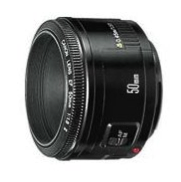
Prime Lenses: Pros
- Prime lenses tend to produce sharper images.
- They tend to perform better in low light conditions.
- They make you take your time when composing your images.
- They are lighter and more compact than zoom lenses.
- They tend to be less expensive than zoom lenses.
Prime Lenses: Cons
- You are not able to zoom in or out.
- You have to physically move in order to change the composition of your photo.
- You may end up carrying more than one lens with you.
Zoom Lens
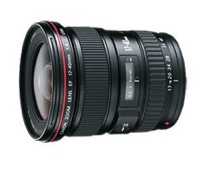
Zoom Lenses: Pros
- You can zoom in and out as needed.
- They can replace two or more prime lenses.
- You do not need to physically change your position in order to recompose your image.
Zoom Lenses: Cons
- Zoom lenses are bulkier and heavier than prime lenses.
- Images may not be as crisp as with a prime lens.
- They may not perform as well as prime lenses in darker situations.
- They tend to be more expensive.
Now that we’ve clarified the difference between prime and zoom camera lenses, let’s take a look at different types of lenses.
Wide-Angle Camera Lens
“Wide-angle” usually refers to lenses with focal lengths between 17mm and 40mm. Wide-angle lenses provide you with a broad view of the scene before you. This makes them ideal for photographing landscapes, small interior spaces that you want to look larger, events like concerts where you are very close to your subjects, street photography, and environmental portraits--portraits that also include your subject’s surroundings. The biggest downside of wide-angle lenses is that they can create distortion--they tend to stretch things out and make them look larger, especially elements that are close to your lens. This makes them a less than ideal choice for portraiture, since they can be unflattering to your subject (no one wants their nose to look too big!).
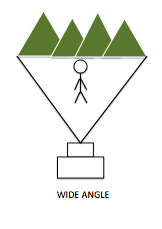
Normal or Standard Camera Lens
Lenses with a focal length of about 40mm to 60mm are considered “normal” lenses because they tend to replicate most accurately what the naked human eye sees. They do not have as much distortion as wide-angle lenses, but they are still wide enough to replicate the peripheral vision of the human eye. Because of these qualities, normal lenses are great for photographing portraits, creating precise compositions, street photography, and documentary photography projects. This is a very useful and flexible lens. When asked which single lens they would choose if they could only have one, many professional photographers answer “my normal lens.”
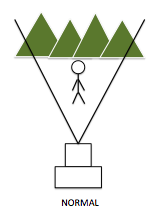
Telephoto Camera Lens
Any lens with a focal length of about 70mm and longer is considered a telephoto lens. These lenses produce the least distortion--making them another excellent choice for flattering portraits. They are also extremely useful in situations where you cannot get too close to your subject--photographing a sports event, or while on safari, for example. The downsides to these lenses is their size and weight--they tend to be quite heavy--and the fact that you cannot photograph subjects that are too close to you.
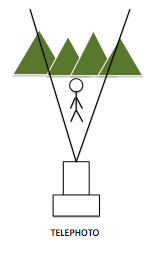
Specialty Camera Lenses: Macro and Fisheye Lenses
Macro lenses are used to create extreme close-up images, typically of very small objects, such as flowers and insects. A macro lens can produce a life-size or even larger-than-life size scale image of tiny subjects. They also allow you to get much closer to your subject than a typical lens while still retaining sharp focus. If you’re interested in photographing nature, or perhaps cataloguing your coin or stamp collection, a macro lens will prove extremely useful. There are some downsides to macro lenses, however. Because you are so close to your subject, you need to keep your camera extra steady, so you may need to use a tripod. Macro lenses also tend to produce images with a very blurry background, so you must be very careful and precise when you focus the lens.
A fisheye lens is an ultra wide-angle lens--any lens with a focal length less than 15mm. These types of lenses tend to have about a 180-degree field of vision. The effect you achieve with this lens makes it seem like you are seeing the world from inside a fishbowl--hence they name, “fisheye.” Everything along the edges of your photo becomes extremely distorted, and your subject will seem much larger than normal. Some common uses of fisheye lenses are for photographing action sports, landscapes, and to capture unusual perspectives. These lenses are great for getting creative--but be warned, their novelty tends to wear off pretty quickly!
No comments:
Post a Comment